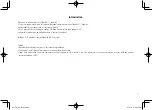
4-6
Issue 1 April 1994
To restore error control to your DataPort 2001, issue either
the AT\N7 command (turns error control ON) or the AT&F
command (restores factory defaults and enables error
control) after the call.
S: You may have a poor telephone line connection. Try dialing
again.
S: Your telephone may have Call Waiting enabled. Refer to
your local telephone book for procedures to disable this
feature.
S: To test your DataPort 2001 hardware, perform a Local
Analog Loopback test (AT&T1) and verify that data entered
at the computer is echoed back to the computer. Before
starting the test, disable Error Control mode using either
the AT\N0 or AT\N1 command. Issue the AT&T1 command,
and begin to enter data from your keyboard. It should
appear on your monitor. To stop the test, escape to
Command mode (+++) and issue the AT&T0 command.
File Transfer
P: You are transmitting a compressed file, but the
throughput seems to be slow.
S: MNP5 data compression can add more overhead to a
compressed file. Turn data compression Off (AT%C0), and
resend the file (if necessary).
P: You experience several errors while transferring a file.
S: Verify that your DataPort 2001 and communications
software are configured for the same type of flow control,
for example, either RTS/CTS (AT\Q3) or XON/XOFF
(AT\Q1).
If you are using XON/XOFF flow control, make sure the
DataPort 2001’s parity matches the computer’s parity.
Verify this within the communications software.
Make sure that your DataPort 2001’s parity matches the
parity of the remote end. A mismatch in parity will cause
flaky errors, such as a single line constantly being
repeated.
















































